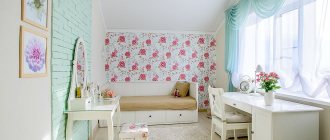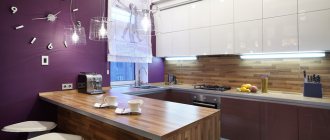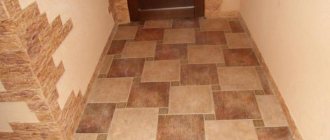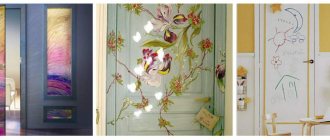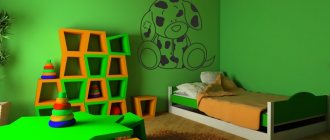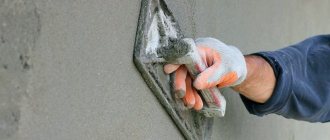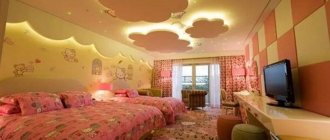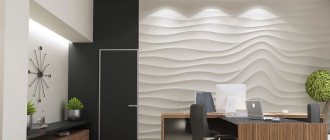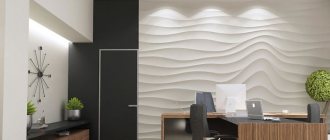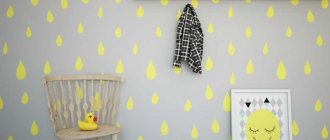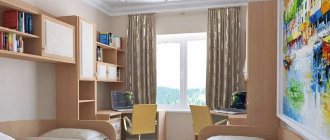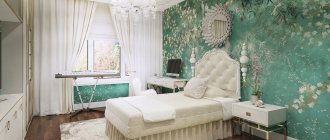Features of wall design
Some nuances should be taken into account:
- For a baby's room, it is advisable to use a more neutral decor so as not to cause visual irritation to the child.
- The materials used for wall decoration must be hypoallergenic, environmentally friendly and safe for health.
- You should choose higher quality and durable wall coverings with the easiest possible maintenance.
- In order to diversify the interior and prevent it from becoming boring, you can combine several finishing options at once.
What is better wallpaper or decorative plaster?
If we talk about expensive wallpaper (based on natural materials), then it is not much different. In terms of practicality, plaster is more reliable. When working with wallpaper, you need to adhere to and observe certain rules and nuances; plastering is much easier. This saves time, effort, and money. Preparing the wall surface is the same for both wallpaper and plastering. True, for the second option no special alignment of the walls is required.
Light and unobtrusive colors are suitable for the bedroom
What walls to choose for a nursery?
The most common and optimal wall finishing options.
Wooden
This coating is environmentally friendly, natural, retains heat well, but at the same time has a fairly high price. Wooden lining or various panels create a comfortable microclimate and can be used around the entire perimeter of the room or in fragments. This type of finishing is rarely used for children's rooms in city apartments.
The photo shows wooden walls in a children's room for a boy.
Slate
The graphite wall is great for chalk drawing. This decor gives the child freedom for creativity and allows him to apply various designs, erase them and draw new ones, thereby creating a unique interior in the room each time.
Painted
An inexpensive design option with a huge variety of shades and textures. Water-based, moisture-resistant or latex paints without toxic components will be especially appropriate for painting a children's room.
Wallpaper
Wall Decor Ideas
A variety of decor will help diversify the monochromatic and simple design of the walls.
Baby stickers
Large or small interior stickers are distinguished by a huge selection, which allows you to choose the most interesting and suitable option for your child:
- lock,
- World map,
- clouds,
- tree,
- butterflies,
- glowing.
The photo shows a sticker in the shape of a tree on the wall in a children's room for a newborn.
Vinyl stickers can be re-glued several times, changing their places and changing the interior each time. Volumetric appliqués also look especially beautiful, creating the illusion of a relief, convex image.
Drawings
Simple bright or complex artistic drawings, single elements or small compositions located throughout the entire space or only partially will add zest to the overall style of the nursery.
Paintings and panels
Paintings with soft images or panels with simple and understandable images will organically fit into the interior of the room and create a truly comfortable environment in it.
Carpets
Wall hangings, whether traditionally rectangular in shape or more complex in design, must not only harmonize with the overall style of the interior design, but also be made from hypoallergenic materials. Such decor with various ornaments and designs will add color to the atmosphere.
DIY crafts
Paper crafts will help enliven the space, add some bright elements to it and focus attention.
The photo shows a nursery for a girl with paper butterflies on the wall.
Photos
Photographs united by one idea will look especially good together and create a single, thoughtful composition. They will bring special tenderness, pleasant moments and memories to the interior.
What does structural plaster look like and what types does it come in?
Structural plaster is a finishing mixture with the addition of decorative pebbles, granules or wood fiber. It can be made from aqueous or organic solvents; the latter option will be an ideal solution for exterior decoration.
Water-based compositions are suitable for interior repairs, because they have virtually no odor, and you won’t have to evacuate your home during the work.
A distinctive feature of structural plaster is its plasticity: the material can be easily applied with any tool.
Another advantage is that structural decorative plaster is sold ready-made in plastic buckets of 15–25 kg.
Wall color in the interior of the room
The color scheme of the wall covering is the main background for the rest of the decor of the room.
Yellow
Evokes associations with the sun, warmth and summer days. Yellow walls fill the environment with joy, positivity and special energy.
Grey
It is an excellent backdrop for the rest of the bright nursery decor. Gray forms a discreet, laconic and calm design.
Blue
Wall decoration in sky blue will bring tenderness and serenity to the room, and make the interior very stylish and beautiful.
The photo shows blue painted walls in a baby's nursery.
Orange
Bright shades of orange create a fresh and positive atmosphere, charge you with a cheerful mood and fill the room with sunshine.
Green and light green
They look unobtrusive, but at the same time very fresh and bright. Mint, green or light green add spring colors, lightness and airiness to the nursery.
Pink
Pink wall decor is most suitable for decorating a girl's room. It will bring warmth, tenderness and fabulousness into the space.
The photo shows a nursery for a newborn and pink walls with drawings.
Lilac
This delicate and sophisticated lilac shade makes the atmosphere very cozy and attractive, conducive to dreams and creative self-development.
Multicolored
A combination of two, three or more colors of the rainbow will dilute the monotonous design and make the room picturesque. The bright striped finish is sure to please the eye.
White
Light and airy shades of white fill the interior with naturalness and purity.
Beige
Ideal for any style and for a child of any age and gender. Beige creates a truly homely atmosphere in which warmth and comfort reign.
Varieties by composition
Floral patterns, ceiling stucco, antique stonework, Venetian, large waves - all this and much more can be created from textured plaster.
Decorative plaster can radically transform a home
The material goes on sale not only in white, but also in any other color, in dissolved form or in the form of dry mixtures. Each type has its own composition, preservatives, and fillers. The appearance of surfaces depends on them.
The structural nature of the coating makes it possible to create different patterns and effects. It doesn’t matter whether it’s a ceiling or a wall, a bathroom or a kitchen, a living room or a bedroom, a nursery or a hallway. Color or combinations thereof, texture or pattern are the exclusive prerogative of the master who works with the mixture. The main thing is that everything is combined with the style, and does not look pretentious and provocative. Based on their composition, the following types of textured plaster are distinguished:
Mineral
Mineral - most often used in the kitchen and bathroom
It is based on cement and is sold in powder form. Endowed with excellent resistance to moisture, suitable for any surface. Can be used in the kitchen and bathroom.
Silicone
Silicone - easy to lay on any surface
This is a ready-to-use mixture and does not need to be diluted. fits well and easily on absolutely any surface, be it wallpaper under plaster, old uneven walls or brick. It has good moisture resistance, suitable for corridors, halls, bathrooms or kitchens. It can be used even on unprepared surfaces.
Acrylic
Acrylic - has good coverage
Liquid material, can be used immediately after opening the package anywhere. It has uniquely good covering ability and high decorative properties. Recommended for decorating living rooms, bedrooms, and children's rooms. The advantage of this material is a wide range of colors. Polymer plaster is similar to this type.
Silicate
Silicate – contains liquid glass
Also available in ready-to-use form. Contains liquid glass. Has excellent adhesive properties. It fits well and masks unevenness. Can serve as a basis for structural types of plaster.
Wall decoration in various styles
Interesting wall decoration in different styles.
- Scandinavian. This style does not require too complex and elaborate decoration. Here preference is given to natural materials that will look incredibly natural.
- Modern. Laconic and harmonious modern design can be diluted with bright accents in the form of wall coverings with geometric shapes, lines or a pleasant combination of different colors.
- Provence. This style is characterized by finishing in pastel colors and shades, floral patterns or wooden coverings, which will give the room even more coziness and tenderness.
- Sea style. White, blue or light blue walls with drawings or stickers in the form of waves, steering wheels or nautical charts will become an integral part of the nautical style.
The photo shows wallpaper with a geometric print on the wall of a nursery in a modern style.
The style of the room primarily depends on the interests, preferences, hobbies and hobbies of the child.
The photo shows a slate wall in the interior of a nursery, made in the Scandinavian style.
Tips from an expert for applying Venetian plaster
- The first layer of plaster is applied evenly over the entire area. This is necessary in order to set the surface to the desired tone and hide the smallest errors in the wall or ceiling.
- After applying each layer, you need to wait until it dries completely, and then sand it off - this will help eliminate defects.
To create a rich color, all shades must have a different tone - lighter or darker. But if you have chosen the shade “wet sand”, then you should not tint it with red or lilac.
- After the first layer, all subsequent layers are applied to create the design. The design is formed using a flexible steel spatula: basic short strokes are applied and the ceiling begins to resemble the skin of a leopard. Subsequent layers are applied to the base pattern, resulting in a slight spotting, which is more reminiscent of a play of light.
It is recommended to cover the walls and ceiling in a damp bathroom with synthetic wax; it creates a water-permeable film.
- After the last layer has been applied and dried, the work is completed by polishing with wax. A layer of natural wax will give the finish a glossy finish, while synthetic wax will add a matte finish.
The final layer, after 20 minutes of drying, is wiped off with a soft, lint-free cloth.
Wall design for a teenager's room
Photo wallpaper, graffiti, intricate illustrations or an accent brick wall will make the design of the room memorable and bright and emphasize the individuality of the room. Most often, the interior is decorated in modern styles, which allow a teenager to develop a sense of taste and self-sufficiency.
The main thing is that the decor is fashionable and stylish, and opens up free opportunities for self-expression.
The photo shows a teenage girl's bedroom with a white brick wall.
Owners' opinion
The reaction of the children and their parents exceeded all the expectations of the designers and organizers of the program! The girl cried with happiness and for a long time could not believe that her dream of her own cozy space had come true. All family members never ceased to be amazed at the unusual decisions of the designers, the original decor and furniture and their organic combination.
The boy especially enjoyed the gears on the wall next to his bed, and even his mother couldn’t resist spinning them. And the young lady rejoiced at the unusual wall covering made with Miracle silk decorative plaster. She noted not only the beauty of the coating, the brightness of the color and stylish shine, but also the new tactile sensations - the wall became very pleasant to the touch. Her brother also touched the wall and was surprised at how unusually soft it had become.
Examples of wall decoration for a girl's room
Use pink, lilac, light yellow or pale blue tones in combination with other shades. If you correctly combine the color balance and add a few bright accents to the space, such as cute pictures, drawings or stickers, you can get a very harmonious and homey design.
Elegant wall decor in combination with delicate and lovely decorations or furniture will help to form a real concept of beauty and aesthetics in a girl.
Photos of walls for a boy's nursery
Bright posters, portraits, cool stickers, handmade crafts or any other design themes against the backdrop of neutral wall colors will help develop the imagination.
The photo shows beige walls decorated with appliqué in a boy’s children’s room.
Of particular interest are images of your favorite superheroes, boy cartoon characters, sea animals, airplanes, stars or space objects.
Paper balls
All kinds of round objects are attractive to kids, so paper balls are an excellent option for decorating a nursery. They will attract the attention of the young resident. If you make them bright and colorful, an atmosphere of lightness and celebration will settle in the room. You can make a ball yourself or buy it in a store. In order not to worry that the child will do something to the decor, you can attach the decoration higher.
You can make paper balls with your own hands Source i.ytimg.com
Modern design Source odinart.ru
Minimalism - design style for a boy's room Source roomester.ru
Wall design ideas for children of different sexes
Companion colors or any other compatible color scheme will allow you to divide the space into certain zones and at the same time maintain the integrity and organicity of the design, and decorate the nursery in the same style. Such decor always looks bright, unique and positive.
Decorating with objects
If the child has developed more or less stable interests, then you can decorate the room with things related to these hobbies. For example, you can give a bean bag chair in the shape of a ball to a passionate football fan. For a hockey fan, create an area with sticks and helmets.
If a boy is attracted to the sea, you can draw a ship on the wall or put a sailboat in the closet, and hang ropes in the room Source vdome.club
Here it is important to take into account the interests of the child himself, and not the parents. If a child is involved in music or sports at the insistence of mom or dad, then an extra reminder about this will only cause a storm of protest and indignation.
Design recommendations for a small nursery
It is not advisable to use too dark or contrasting wall coverings and to use too many ornate wall decorations. It is better to give preference to light shades, which will visually soften and increase the size of a small space.
How to decorate parts of the wall in the nursery?
Wall accents can balance and complete a room.
- Above the bed. This design technique allows you to add versatility and interest to the interior. The decorated space above the bed, in tune with the general style direction, will add individuality to the decor.
- Accent wall. It can be decorated using photo wallpaper, bright colors, wallpaper with variegated and large patterns, or other materials with a voluminous texture. This accent will become the main visual focus and will concentrate the main attention on itself.
The photo shows an accent wall with plant patterns in the bedroom of a teenage girl.
Thanks to the play of contrasts, you can create the main eye-catching visual point in the room.
How to apply structural plaster: step-by-step instructions with photos
Application of structural plaster takes place in several stages:
- Surface preparation: removing old finishes, removing debris and dust.
There is no need to perfectly level the wall or ceiling; the structural coating will hide minor unevenness. The main thing is that the surface is clean.
- The surface of the ceiling or wall is strengthened with a primer, which will become the basis for adhesion of the finish. After the primed surface has completely dried, you can proceed to the next stage of work.
The primer prevents moisture exchange between the ceiling and the decorative coating in the bedroom, living room, and children's room. And for the bathroom and kitchen, instead of a primer, sanitizing plaster can be used.
- Take a trowel or spatula and begin applying the structural plaster using straight or circular movements. After a few hours, the coating will harden, but the quality of the work performed can be judged after 1 week.
